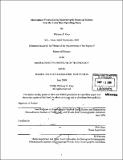| dc.contributor.advisor | Mark Saito. | en_US |
| dc.contributor.author | Krey, Whitney B. (Whitney Blair) | en_US |
| dc.contributor.other | Woods Hole Oceanographic Institution. | en_US |
| dc.date.accessioned | 2008-11-07T19:04:13Z | |
| dc.date.available | 2008-11-07T19:04:13Z | |
| dc.date.issued | 2008 | en_US |
| dc.identifier.uri | http://hdl.handle.net/1721.1/43114 | |
| dc.description | Thesis (S.M.)--Joint Program in Oceanography/Applied Ocean Science and Engineering (Massachusetts Institute of Technology, Dept. of Biology; and the Woods Hole Oceanographic Institution), 2008. | en_US |
| dc.description | Includes bibliographical references (p. 54-59). | en_US |
| dc.description.abstract | (cont) An increased understanding of heterotrophic bacterial strategies for acquiring nutrients and trace elements is critical for elucidating their impact on biogeochemical cycling in the ocean. It is estimated that iron is a limiting nutrient for phytoplankton growth in over 30% of the open ocean, but still little is known about bacterial strategies for iron acquisition. Siderophore (Fe ligand) production by bacteria may play a major role in influencing the bioavailability of iron in the ocean. Despite the importance of siderophores in the environment, only limited information from a select group of bacteria is available. On a cruise through the Costa Rica Dome (CRD) upwelling region in July 2005, a library of 867 isolates from five depth profiles inside and outside of the dome was obtained and screened for siderophore production using the Chrome Azurol-S (CAS) assay. Phylogenetic affiliation of 134 isolates was determined by sequencing the 16s rDNA gene, and determined that gamma proteobacteria such as Alteromonas, Pseudoalteromonas, Halomonas, and Marinobacter dominated the collection, while alpha-proteobacteria such as Roseobacter were also represented. The isolates obtained from stations in the CRD showed greater siderophore-producing capabilities between 55m and 100m while strains isolated from outside the CRD had shallower peak (-8-35m) production. Functional group determination showed that hydroxamate production dominated from 50-150m, while hydroxamate and catechol production is roughly equal in shallower waters. By characterizing the siderophores produced by these isolates and determining the genetic make-up of the population, these findings further our understanding of how heterotrophic microbes affect biogeochemical processes and the competitive nature of nutrient acquisition. | en_US |
| dc.description.statementofresponsibility | by Whitney B. Krey. | en_US |
| dc.format.extent | 59 p. | en_US |
| dc.language.iso | eng | en_US |
| dc.publisher | Massachusetts Institute of Technology | en_US |
| dc.rights | M.I.T. theses are protected by
copyright. They may be viewed from this source for any purpose, but
reproduction or distribution in any format is prohibited without written
permission. See provided URL for inquiries about permission. | en_US |
| dc.rights.uri | http://dspace.mit.edu/handle/1721.1/7582 | en_US |
| dc.subject | /Woods Hole Oceanographic Institution. Joint Program in Oceanography/Applied Ocean Science and Engineering. | en_US |
| dc.subject | Biology. | en_US |
| dc.subject | Woods Hole Oceanographic Institution. | en_US |
| dc.subject.lcsh | Siderophores | en_US |
| dc.subject.lcsh | Bacteria, Heterotrophic | en_US |
| dc.title | Siderophore production by heterotrophic bacterial isolates from the Costa Rica upwelling dome | en_US |
| dc.type | Thesis | en_US |
| dc.description.degree | S.M. | en_US |
| dc.contributor.department | Joint Program in Oceanography/Applied Ocean Science and Engineering | en_US |
| dc.contributor.department | Woods Hole Oceanographic Institution | en_US |
| dc.contributor.department | Massachusetts Institute of Technology. Department of Biology | |
| dc.identifier.oclc | 245046019 | en_US |
